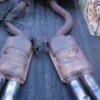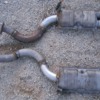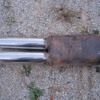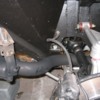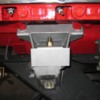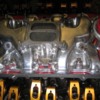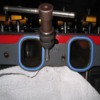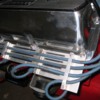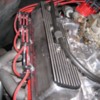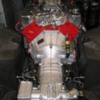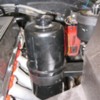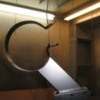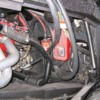The car ran cats instead of mufflers and the modifications were made using the original Pantera muffler pipes. The chrome on the tips was also cooked. Here's a shot of the pipes as they were removed.
Here's a shot of the cat installed. I had forgotten to fabricate the muffler mount for the right side---here it is freshly fabbed and test mounted before blasting, painting and being permanently installed a bit later.
Attachments
This shot shows one of the items we installed on all of the AmeriSport assembled GT5-S cars to help protect the rubber motor mounts from radiant header heat. It's a simple piece of bent aluminum but was quite effective is saving the rubber from the excessive header heat.
Looking forward to any questions---I will go through the engine details later on.
Looking forward to any questions---I will go through the engine details later on.
Attachments
always wondered how you tackled the cat issue. Simple and effective.
This guy is getting virtually a new car back from you. he's gotta' be a very happy camper.
The car is going to be better now than it ever was new.
This guy is getting virtually a new car back from you. he's gotta' be a very happy camper.
The car is going to be better now than it ever was new.
Kirk,
A few questions:
1. Are there differences between the GT5-S bodied chassis and the Ford-era chassis? Can you use the same jig for both in other words?
2. Do you paint your motor mounts with a high temp paint?
3. Does the catalytic converter/muffler restrict the exhaust appreciably and/or does it quiet the car down at all?
A few questions:
1. Are there differences between the GT5-S bodied chassis and the Ford-era chassis? Can you use the same jig for both in other words?
2. Do you paint your motor mounts with a high temp paint?
3. Does the catalytic converter/muffler restrict the exhaust appreciably and/or does it quiet the car down at all?
I'm loving this thread!! Thanks for sharing Kirk.
Great Job Kirk!
I love that you saved the car from a total.
I love that you saved the car from a total.
Hello Kirk,
I am highly impressed with your skills and attention to detail. Thanks for sharing.
Shah
I am highly impressed with your skills and attention to detail. Thanks for sharing.
Shah
[QUOTE]Originally posted by Slightlycrispy:
Kirk,
A few questions:
1. Are there differences between the GT5-S bodied chassis and the Ford-era chassis? Can you use the same jig for both in other words?
Yes there are many differences. The late model cars 9000 vin and up I think were hand built in a similar fashion to very early 71 cars. Frankly the full production version is stronger and stiffer. Reasons for this range from sheet metal that has been stressed stamped into a shape over hand broke flat stock to integrated internal structures to stiffen and spread load over off the shelf materials like tubing to build bolt sleeves into the frame for the rear A-arm mounts. The late model cars are fantastic for how they were built---just apples and oranges to use a cliché. I look at it this way---if you own a Pantera no mater what year, enjoy it---nothing else matters.
2. Do you paint your motor mounts with a high temp paint?
No need---never have had a problem with paint blistering from heat on the mounts---just the rubber decaying for heat.
3. Does the catalytic converter/muffler restrict the exhaust appreciably and/or does it quiet the car down at all?
I tested my original cat mufflers we made in-house and used on the GT5-S cars against all of the mufflers that were available at that time----6 or 7 years ago and the cats made the best HP out of every muffler. The back pressure at full throttle was just over 1 pound and sounded great. BUT can you use this type of muffler on a 750 Holley carbed 393 stroker with a massive roller cam, Parker funnel web--so-so-so NO! You will cook them quite fast. They work quite well when you keeping the air fuel ratio close to 14.7 or at least in the 14 range.
Off to see Lone Survivor
Kirk,
A few questions:
1. Are there differences between the GT5-S bodied chassis and the Ford-era chassis? Can you use the same jig for both in other words?
Yes there are many differences. The late model cars 9000 vin and up I think were hand built in a similar fashion to very early 71 cars. Frankly the full production version is stronger and stiffer. Reasons for this range from sheet metal that has been stressed stamped into a shape over hand broke flat stock to integrated internal structures to stiffen and spread load over off the shelf materials like tubing to build bolt sleeves into the frame for the rear A-arm mounts. The late model cars are fantastic for how they were built---just apples and oranges to use a cliché. I look at it this way---if you own a Pantera no mater what year, enjoy it---nothing else matters.
2. Do you paint your motor mounts with a high temp paint?
No need---never have had a problem with paint blistering from heat on the mounts---just the rubber decaying for heat.
3. Does the catalytic converter/muffler restrict the exhaust appreciably and/or does it quiet the car down at all?
I tested my original cat mufflers we made in-house and used on the GT5-S cars against all of the mufflers that were available at that time----6 or 7 years ago and the cats made the best HP out of every muffler. The back pressure at full throttle was just over 1 pound and sounded great. BUT can you use this type of muffler on a 750 Holley carbed 393 stroker with a massive roller cam, Parker funnel web--so-so-so NO! You will cook them quite fast. They work quite well when you keeping the air fuel ratio close to 14.7 or at least in the 14 range.
Off to see Lone Survivor
Engine was OK from the crash---well built from a builder on the east coast. During the engine clean-up, re-paint, assembly before testing, I discovered one of the 5/16 bolts on the intake was stripped so I had to do a cylinder head-on repair. Got-ta hate when that happens.
Attachments
A different view of the bracket. Also shown are 2 of the hidden wiring caps used to hold the AC hoses and wiring along the upper rail without positive loop hold downs---make's the hoses/wiring faster to install and/or remove later on.
Attachments
Kirk
I am amazed at the artristry and have studied the photo's in hopes to learn the details of putting mione together.
I have a question on the second photo going back that shows the location of the coil/MSD/solenoid. Just to the right of the solenoid is a straight pipe-like object I can't identify. what is that? (coolant expansion tank overflow?)
Also, is that photo taken through the removed rear quarter gill?
Joe
I am amazed at the artristry and have studied the photo's in hopes to learn the details of putting mione together.
I have a question on the second photo going back that shows the location of the coil/MSD/solenoid. Just to the right of the solenoid is a straight pipe-like object I can't identify. what is that? (coolant expansion tank overflow?)
Also, is that photo taken through the removed rear quarter gill?
Joe
quote:Originally posted by Kirk Evans:
Here's the ignition control sub assembly with the MSD box mounted in a more appropriate location---IMHO
The Pantera-Electronics controller is the same dimension as the MSD. It has many additional features to the MSD, including...it doesn't require a tach adapter and it works ALL of the time.
Just to the right of the solenoid is a straight pipe-like object I can't identify. what is that? (coolant expansion tank overflow?)
I do not remember, sorry.
Also, is that photo taken through the removed rear quarter gill?
No through the wheel opening with the shieldout.
The Pantera-Electronics controller is the same dimension as the MSD. It has many additional features to the MSD, including...it doesn't require a tach adapter and it works ALL of the time.
This car was finished 3 years ago and I do not believe Jon had his system available---and the customer already had the MSD. I personally have never experienced a MSD failure but have modified several cars to run the MSD only under boost or as needed manually so the radio worker better. Bother car requires 2 separate control systems--one ran a Dura spark and one ran a standard unilite. The Dura advantage was it retarded the ignition during starting.
Pantera-Electronics is the real-deal making fantastic items to improve the car. I have not ran the ignition control module but if it's like everything else Jon makes, it will be first class.
I do not remember, sorry.
Also, is that photo taken through the removed rear quarter gill?
No through the wheel opening with the shieldout.
The Pantera-Electronics controller is the same dimension as the MSD. It has many additional features to the MSD, including...it doesn't require a tach adapter and it works ALL of the time.
This car was finished 3 years ago and I do not believe Jon had his system available---and the customer already had the MSD. I personally have never experienced a MSD failure but have modified several cars to run the MSD only under boost or as needed manually so the radio worker better. Bother car requires 2 separate control systems--one ran a Dura spark and one ran a standard unilite. The Dura advantage was it retarded the ignition during starting.
Pantera-Electronics is the real-deal making fantastic items to improve the car. I have not ran the ignition control module but if it's like everything else Jon makes, it will be first class.
Wow! Came out beautiful Kirk. Hope the owner appreciates what you did. I do. It's a magnificent car. 
Beautiful car - Kirk you are an artist.
Devin
Devin
Thanks for sharing, the repairs turned out awesome!
Fantastic work Kirk. Sexy colour, what is it,
it's what i was hoping for 13 yrs ago and ended up with a very plain red. love it.
it's what i was hoping for 13 yrs ago and ended up with a very plain red. love it.
Hi jjenn.
Welcome to "Club damaged cars".
Mine is 9053 (dont know hav to uplode Photos)
I think it is possible to repair car 6672 and yours also. not so bad at all.
With the right skills, tools, time and money almost ewerything is possible!
Dont know if you know this one.
www.rscorse.com (look under Detomaso store)
They have rear fenders. 1650euro each.
Kjeld
Welcome to "Club damaged cars".
Mine is 9053 (dont know hav to uplode Photos)
I think it is possible to repair car 6672 and yours also. not so bad at all.
With the right skills, tools, time and money almost ewerything is possible!
Dont know if you know this one.
www.rscorse.com (look under Detomaso store)
They have rear fenders. 1650euro each.
Kjeld
No worries---here is a crashed Italian from several years ago with a ton of damaged front end parts including ABS controls, the complete AC evaporator and heater box with blower. Many other frontal items required replacing or repairs not including the sheet metal. It took a hard front end hit.
Attachments
Here we are all most ready for the new sheet-metal and fiberglass internals. One thing that was incredible---when I started installing the new front end, all of the rivet holes on the internal fiberglass shrouding lined up the frame---and I mean all of them. It didn't even require pressure to install the 1/8" rivets from the fiberglass to the sheet-metal---I've drilled mounting holes using the part to be mounted and they have not lined up that good. A big salute to Ferrari on this one.
Attachments
Nose on--the customer did his own painting which we often do for people on reconstruction jobs---rust of collision. The lines on the fender helped me check the metal shaping on the left fender which was slightly damaged on the new front clip. We were very lucky to find another very late 328 that was smoked on the left rear. I bought the whole car and was going to build a toy targa 288 wan-na-be.
Attachments
Kirk,
What does something like the rebuild of this GT5-S cost?
Thanks,
Cliff
What does something like the rebuild of this GT5-S cost?
Thanks,
Cliff
Add Reply
Sign In To Reply


